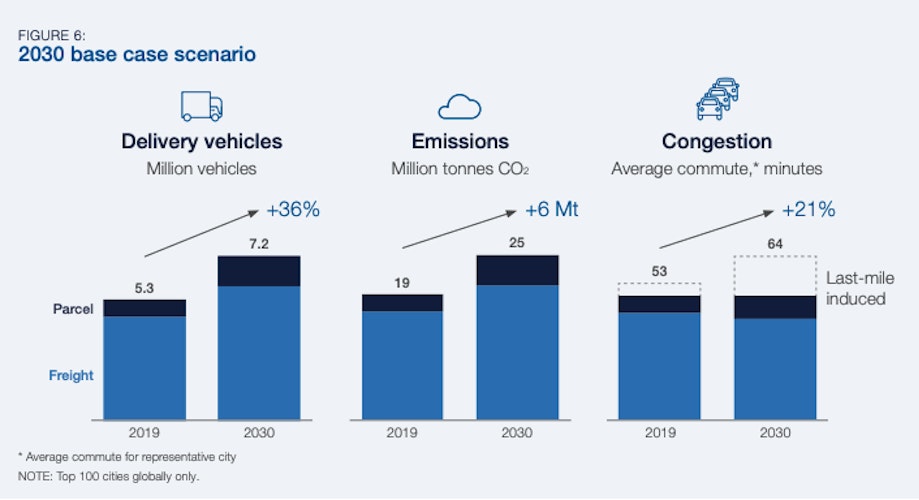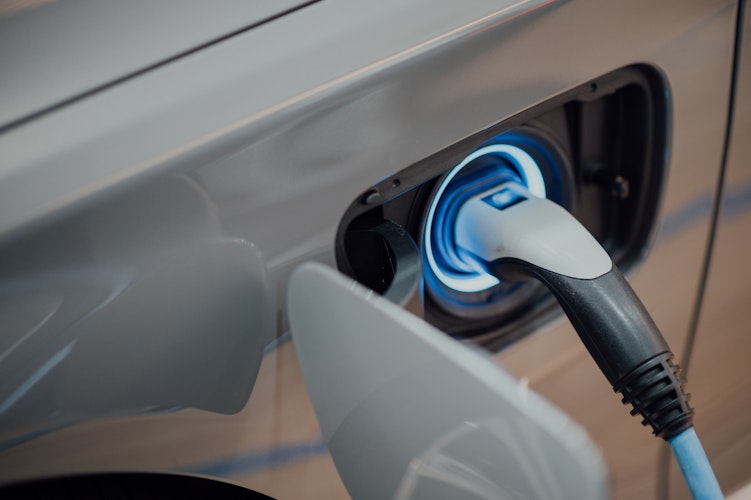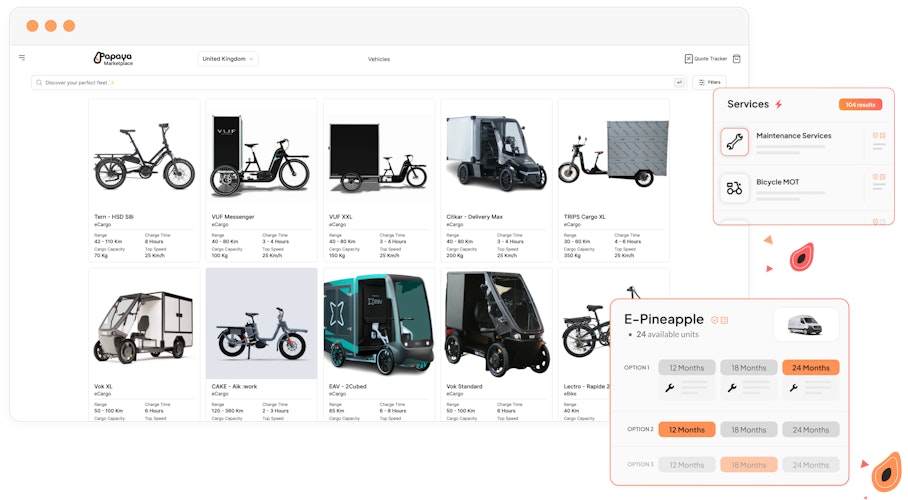The Road to Fleet Electrification: How Last-Mile Fleet Electrification Is Driving Opportunities
E-commerce is booming…
Consumers increasingly turn to online platforms to meet their everyday needs, driven by extensive product selection, swift deliveries, and flexible return policies. As e-commerce continues to thrive, the demand for last-mile delivery is expected to grow by 78% globally by 2030, resulting in a surge in the emissions associated with last-mile deliveries. This places the last-mile delivery sector in a pivotal role within urban logistics and brings forth fleets' environmental challenges.
Traditional fuel-powered fleets contribute to air pollution, traffic congestion, and noise disturbance, compromising the overall quality of urban life. In order to tackle these pressing issues, a shift towards electric commercial fleets for last-mile deliveries becomes imperative. This transition mitigates the adverse environmental effects while offering significant advantages for fleet operators.
TL;DR
The electrification of commercial fleets is an imperative step toward a greener, more efficient, and cost-effective last-mile transportation system. And it is not impossible to achieve. Around a fifth of DHL's delivery fleet is now zero-emission vehicles, while Fedex has been using electric vehicles since 2010.
From cost savings and improved operational efficiency to environmental sustainability and brand enhancement, the advantages of electrifying commercial fleets are compelling. Technological advancements and innovations have made electric commercial fleets more efficient, practical, and adaptable, reducing barriers to the wider adoption of EVs.
The Need for Last-Mile Commercial Fleet Electrification
Tackling the Emission Problem
Last-mile commercial fleets contribute significantly to greenhouse gas emissions and air pollution, accelerating global warming, smog formation, and respiratory issues.
Last-mile delivery emissions are projected to surge by over 30% globally by 2030. This would result in an annual release of 25 million tons of CO2. To put this into perspective, in 2022, the six most polluting delivery and e-commerce companies emitted a staggering 4.5 million tons of CO2 worldwide. This is equivalent to the CO2 emissions produced by one million petrol-powered passenger vehicle journeys.
Source: World Economic Forum - The Future of the Last-Mile Ecosystem
Transitioning commercial fleets to electric vehicles (EVs) presents a solution to dramatically reduce emissions and curb air pollution. EVs produce zero tailpipe emissions, effectively reducing the release of harmful pollutants into the atmosphere. This is crucial for mitigating the environmental impact of last-mile deliveries and fostering healthier, more sustainable communities.
Navigating Regulatory Shifts and Preparing for Future Changes
Commercial fleet electrification extends beyond mere conviction or the desire to position businesses as more sustainable. It is rapidly evolving into a legal and compliance matter.
The electrification of commercial fleets aligns with the global objective of reducing carbon footprints. As countries strive to achieve their emission reduction targets, the adoption of electric commercial fleets becomes an opportunity to make progress. Many European countries and cities have already implemented net-zero goals, low-emissions zones and are about to ban the sale of new ICE (Internal Combustion Engines) vehicles.
However, in 2022, only 34% of UK fleets were on track to achieve their net-zero goals by 2030. In contrast, 42% had made no preparations. Businesses must recognise the time-sensitive nature of this transition and proactively embrace the shift toward electric commercial fleets. By doing so, they can meet legal requirements while future-proofing their business and gaining more control over the transition.
The Advantages of Commercial Fleet Electrification
Fleet electrification is a real opportunity for fleet operators. From economic benefits to environmental sustainability, electrifying last-mile commercial fleets presents an array of benefits.
Lowering Total Cost of Ownership (TCO) with Reduced Fuel and Maintenance Costs: Electric vehicles tend to have lower operating costs compared to traditional combustion engine vehicles. With electricity generally being cheaper than gasoline or diesel fuel, businesses can experience savings in their fuel expenses. Additionally, EVs have fewer moving parts and require less frequent maintenance, resulting in reduced maintenance and repair costs over the vehicle’s lifetime.
Reducing Downtime: The maintenance requirements for EVs are typically simpler and less time-consuming. Fewer fluid changes, no oil changes, and reduced wear on braking systems contribute to reduced downtime and increased vehicle availability.
Improving Environmental Sustainability: By transitioning to electric vehicles, commercial fleets can significantly reduce their carbon footprint and environmental impact. EVs produce zero tailpipe emissions, effectively reducing the release of greenhouse gases and harmful pollutants. The reduction in emissions contributes to cleaner air, improved public health, and a more sustainable future.
Building Better ESG Credentials: Electric fleets brings significant benefits for a company's Environmental, Social, and Governance (ESG) credentials. This aligns with growing investor for more eco-friendly practices. Electric fleets have both positive environmental and social implications. They contribute to improved air quality and reduced noise pollution, creating healthier and more livable communities. That can enhance a company's ESG profile, making it more attractive to investors and other stakeholders.
Boosting Brand Reputation and Competitive Edge: Commercial fleet electrification can enhance a company's brand reputation and give it a competitive edge in the market. In an era where consumers are increasingly conscious of sustainability, prioritising cleaner transportation can improve businesses' value proposition and attractiveness. Electric fleet operations can also differentiate a company from competitors, opening doors to new opportunities and partnerships.
Benefitting From Tax and Financial Incentives: Governments worldwide are introducing various tax incentives and financial benefits to encourage the adoption of electric vehicles. These incentives may include tax credits, rebates, grants, or exemptions from certain fees or charges. By electrifying their commercial fleets, businesses can take advantage of these incentives, further reducing upfront costs. EVs may also qualify for lower insurance premiums due to their lower risk of accidents and reduced environmental impact.
Optimising Energy Efficiency: Commercial fleet electrification also opens doors to increased energy efficiency and renewable energy integration. By charging EVs during off-peak hours, businesses can take advantage of lower electricity rates and optimise their energy consumption. Furthermore, by incorporating renewable energy sources into their charging infrastructure, businesses can further reduce their carbon footprint.
The advantages of electrifying commercial fleets extend beyond the bottom line. The potential for operational efficiencies and positive environmental impact make commercial fleet electrification a compelling choice for forward-thinking organisations.
Overcoming Challenges and Barriers
While the electrification of commercial fleets offers significant advantages, there are several challenges that need to be addressed. By proactively overcoming these obstacles, businesses can successfully navigate the path to commercial fleet electrification.
Developing The EV Charging Infrastructure: One of the primary challenges for last-mile fleet electrification is the availability and accessibility of EV charging infrastructure. Businesses need a reliable and widespread network of charging stations to support their fleet operations. To overcome this challenge, stakeholders, including governments, utility companies, and businesses, are actively working to expand the charging infrastructure.
💡 Top tip: Light electric vehicles such as cargobikes and ebikes tend to be quicker and easier to charge, and usually require less infrastructure. They are particularly well-suited for last-mile deliveries. In 2022 it was estimated that cargo bikes could replace around 51% of all motorised freight trips in European cities. In London 25% of the loads currently carried in light vans could be transferred to cargo bikes. Consider replacing your ICE vehicles with light electric vehicles to ease the burden on your charging infrastructure and minimise initial investments!
Covering The Initial Investment Costs: The upfront costs associated with transitioning a commercial fleet to electric vehicles can be a barrier for some businesses. Electric vehicles often have a higher purchase price compared to traditional combustion engine vehicles. However, it is essential to consider the total cost of ownership (TCO) over the vehicle's lifetime. Factors such as lower fuel and maintenance costs, tax incentives, and potential grants or subsidies can offset the initial investment. Moreover, as technology continues to evolve and scale, the costs are expected to decrease, making electric vehicles more cost-competitive.
💡 Top tip: Purchasing is not your only option! All-inclusive subscriptions or rental schemes are now widely available for most electric vehicles. They offer more flexibility and minimise both the initial investment and financial risk typically associated with purchasing. This gives you the time to test and understand what works best for your fleet.
Finding The Right Vehicles: The availability and variety of commercial electric vehicles have been a limitation in the past. However, the market is rapidly expanding, with many automakers introducing models specifically designed for commercial use. 79% of fleet decision-makers agreed that there are more EVs on the market to suit their needs now. From e-cargobikes to e-vans, last-mile businesses now have a wide range of options to choose from.
💡 Top tip: When electrifying, always consider your use case and available infrastructure as well as specific load, range and price requirements. Don’t limit yourself to a vehicle type as, for example, an e-van might not always be the best option to replace a van. Consider all your options from e-cargo bikes to e-vans.
Finding The Right Service Providers: Electrifying a fleet also means finding the right service providers. This includes identifying reliable suppliers of electric vehicles (EVs), maintenance, insurance, charging infrastructure, and other related services. Companies need to ensure that they find service providers with the expertise and capacity to meet their specific fleet requirements. This is critical to ensure a successful electrification journey.
💡 Do your due diligence. Allocate enough time to compare multiple suppliers and ask them the right questions: have they worked with your type of vehicle before? do they know your industry well? where are they operating? what is their capacity? what system do they use to communicate with you? what is their pricing structure? It will require some time but you’ll be sure of the service you will get.
Managing Fleet Downtime: in 2022 over half of non-EV fleet managers anticipated an increase in vehicle downtime with the introduction of EVs. In contrast, just 24% of EV fleet managers said that they had realised that increase; making downtime less of an issue than initially anticipated. Charging time is another side of the problem. The time it takes to charge an electric vehicle is typically longer compared to refuelling with traditional fuels. However, this challenge can be mitigated by utilising smart charging strategies and infrastructure. Charging can be scheduled during periods of vehicle downtime, such as overnight or during breaks, to minimise the impact on operations.
💡 Implement fleet management systems to streamline the way your commercial fleet is operated. With advanced IoT, data analytics, and maintenance capabilities, it enables real-time monitoring of vehicle performance, battery health, and charging status. Fleet managers can anticipate downtime, ensuring more efficient operations while optimising costs.
Overcoming Range Anxiety: The fear of running out of battery power before reaching the destination is another concern for commercial fleet operators. However, advancements in EV technology have significantly increased the driving range of electric vehicles, alleviating this concern. Last-mile or urban delivery services typically cover around 50–150 km per day, a distance that most LEVs can cover. With 70% of non-electric light commercial vehicles in European urban transport travelling less than 100 km per day, EVs can easily be used.
💡 Strategically plan your routes, optimise your charging schedules, leverage telematics and implement fleet management solutions to monitor and manage your electric fleet efficiently. And make sure to consider range capacity when choosing your electric vehicles.
Supporting Workforce Transition: transitioning to electric fleet operations requires training to handle the unique aspects of EV maintenance, charging infrastructure management, and range optimisation. Offering training programs and workshops can equip fleet managers, technicians, and drivers with the necessary knowledge and skills.
💡 Provide your workforce with the right tools to help them achieve their objectives and to simplify the transition.
By acknowledging and addressing these challenges, businesses can successfully overcome barriers to commercial fleet electrification. Government support and regulations as well as technological advancements play a vital role in accelerating the electrification of commercial fleets and help commercial fleet operators unlock the full potential of their fleet and reap the benefits.
In a nutshell…
The electrification of commercial fleets is an imperative step toward a greener, more efficient, and cost-effective last-mile transportation system. And it is not impossible to achieve. Around a fifth of DHL's delivery fleet is now zero-emission vehicles, while Fedex has been using electric vehicles since 2010.
From cost savings and improved operational efficiency to environmental sustainability and brand enhancement, the advantages of electrifying commercial fleets are compelling. Technological advancements and innovations have made electric commercial fleets more efficient, practical, and adaptable, reducing barriers to the adoption of EVs.
The future of commercial fleet operations is electric. Join the electrification revolution now with Papaya vehicle management and marketplace platforms. Our team of experts can help you along your electrification journey, from sourcing the right vehicles to managing them more efficiently. Book a demo now to learn more.
Papaya is here to help!
Papaya’s Marketplace is a great place to start when thinking about electrifying your commercial fleet. It is the one-stop platform to compare:
different vehicle types, ranging from e-cargo-bikes to e-vans, based on your price, load and range requirements. You find the perfect vehicle for your fleet with just a few clicks.
different package options, ranging from purchase to renting and all-inclusive subscriptions. You choose the option that suits you best, minimising the financial risk.
different service providers. Browse our wide selection, ranging from maintenance to IoT or insurance providers and interact with them directly, in a single platform.
Papaya is also a vehicle and fleet management platform, enabling fleet operators to streamline their operations by directly interacting with all their service providers from a single platform. With data analytics, and maintenance capabilities, it enables real-time monitoring of vehicle and hub performance, simplifies ticket creation and allows fleet managers to anticipate downtime.
With Papaya, you onboard all your stakeholders on a single platform, streamline communications and simplify your operations. You can focus on minimising costs and increasing uptime and vehicle availability.











